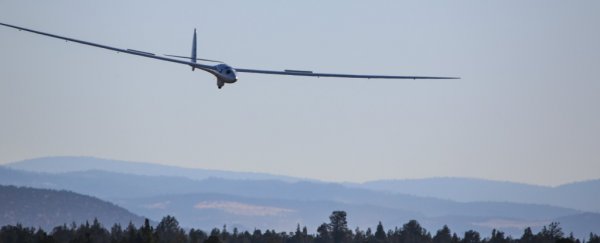Engineers in South America hope to become the first glider pilots to ever reach the edge of space (or Kármán line) - a threshold that requires them to surf on waves of air up to an altitude of 90,000 feet (27,000 metres).
Besides earning them a place in the history books, the team says if their plan is successful, they will be sending even more gliders into the upper reaches of the atmosphere to measure pressure, ozone, and electromagnetic fields, to researchers learn more about our planet.
"The Airbus Perlan Mission II intends to set new altitude records by flying the Perlan 2 higher than any other manned wing-borne aircraft has ever flown in sustained flight, using stratospheric mountain waves and the polar vortex," the team said on their website.
"In so doing, [we will] harvest invaluable data about Earth's atmosphere and its ozone layer."
To pull it off, the team designed a glider that has an 84-foot (25.6-metre) long wingspan, a pressurised cabin, and the ability to withstand the dramatic drop in air pressure that comes with soaring in the upper levels of our stratosphere.
But since gliders, you know, glide, and don't have engines or rockets on to shoot them up so high, how will they pull this off?
Simple: they'll surface on a column of air.
Yup, in order to reach the edge of space, the team will ride stratospheric mountain waves, which are basically strong gusts of wind that rise upward from mountain ranges between warm and cold air systems that are coupled with a polar vortex, allowing them to travel farther up into stratosphere than normal mountain waves.
"The southern and northern regions of the world have a phenomenon called the polar vortex, and basically what that does is it causes strong winds at very high altitudes," chief pilot Jim Payne, told Woodrow Bellamy III at Avionics.
"In our case, the strong winds will be perpendicular to the Andes and as they come over the mountains, they cause a wave in the air that's invisible unless there are clouds present. We fly in the area where the air is rising, and propagates all the way up to 90,000 feet [27,000 metres], although meteorologists say it may go up to 130,000 feet [40,000 metres]."
Right now, the team is waiting in Patagonia for the ideal conditions for testing, though it's been a rather disappointing couple of months, because polar vortexes, which typically occur around this time of year in South America, have been sparse.
"Typically, the polar vortex, which causes the high-altitude wave, is best in August and September," Payne said, according to Kacey Deamer at Live Science.
"So far, August has been disappointing; we haven't had the high-altitude winds. The one downside of this is that we're totally at the mercy of the weather."
If the team is able to pull off their feat, they will be the first to ever reach an altitude of 90,000 feet without needing any sort of fuel to do so, which would be pretty incredible.
And they aren't the only team currently experimenting with gliders. Over the last couple of years, the Solar Impulse 2 team has been breaking record after record by flying their glider across the entire globe. Their craft recently cruised at an altitude of 28,000 feet (8,543 metres).
The real win for these types of technologies is that they showcase what can be done without needing to rely on fuel. By doing so, these researchers hope that other teams will follow suit by creating new gliders for research missions and one day maybe human travel.
Hopefully, with South America's winter season in full swing right now, the Perlan team will find the conditions they need to give it a shot. Until then, we'll just have to wait and see.
